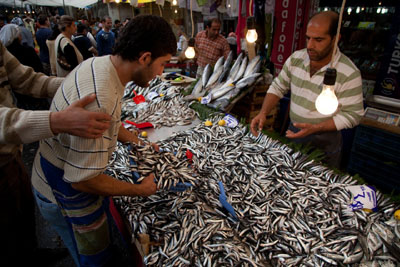Wednesday
AdviceSince You Asked: Istanbul’s Fish Scene?

I am just back home from a cruise to Turkey, which included a short stay in Istanbul. I was pleasantly surprised to find such a strong seafood culture there. Shame on me for expecting lamb, lamb and more lamb! I indulged and managed to identify some of the fish I ate, but I didn’t catch the name and preparation of so many more. Can you help me fill in some of the question marks I have in my trip notes?
Thanks in advance,
Fishermom
Berlin, N.H.
Dear Fishermom,
You are not alone. We’ve received many such notes from readers surprised by the seafood bounty in Istanbul. So we put together a light crash course in what swims through here. Follow the links to reviews of some of our favorite places to eat these fish.
Levrek – Sea bass is one of the most popular fish in Turkey, prized for its delicate, almost sweet taste and firm white meat. Levrek is usually charcoal grilled whole and served with a drizzle of oil and a squeeze of lemon. In another delicious version, a whole levrek is encased in sea salt and baked in the oven. One of our favorite preparations is kagitta levrek, in which sea bass filets are wrapped in a paper bundle with onion, tomato and lemon and baked. Many restaurants serve the cheaper and smaller farmed variety of the fish. Wild levrek is known as deniz levregi. Both are available all year.
Hamsi – Size isn’t everything: the finger-length anchovy is often referred to in Turkey as the “little prince” of fishes. In the Black Sea area, where hamsi are caught, the little fish are used in numerous dishes and form an important part of the local economy. The most popular way hamsi are served is fried in a light coating of corn meal but we’ve even found them skewered and grilled. Another popular recipe is hamsi pilav – a rice and anchovy dish infused with an aromatic mix of herbs and spices. The hamsi season is in the fall and winter.
Cipura – Gilthead bream is the most popular fish caught in the Aegean area. Like levrek, it is a mild tasting fish with white, flaky meat, usually grilled whole and served unadorned. Fish farms now supply much of the Cipura served in restaurants, but the wild variety, known as deniz cipurasi is also available.
Barbunya – Tasty small red mullets are another popular fish. As the name implies, the barbunya’s skin is speckled with glistening reddish spots. The mild-tasting fish, usually only a few inches long, are typically pan-fried whole and an order of them can easily be shared. Barbunya’s prime season is from spring through early summer and the fish is not farmed.
Palamut – Bonito, related to tuna, is a fish that appears in Turkey’s waters in fall through winter. Unlike levrek and cipura, it is a strong-tasting, oily fish, similar to mackerel. Palamut fillets are often grilled, but another popular – and perhaps tastier – way they are prepared is baked in the oven in an onion and tomato sauce. Palamut is not farmed.
(photo by Jonathan Lewis)
Related Posts
Post Tags: fish, Istanbul restaurants, seafood








Feb 24, 2010
Reply
C’mon man! You can do better than this!
Feb 24, 2010
Reply
Where are the sardines (sardalye)? They’re not my personal favorite but people care so much about them that they even organize Sardine Festivals in Gallipolli.
Sardines are the fish of Marmara Sea and Dardanelles.You can fry them or cook them in the oven with vegetables but the best way to cook sardines is “boklu kebap”, which roughly means filthy kebab. The reason why it is filthy is that you don’t take the innards or backbones of the fish. You also keep the scales on but it’s better to wash the fish carefully.
The secret of boklu kebap is you roll the fish in grape leaves and grill them (preferably on coal). When they’re done, you unroll the leaves and the scales also come off on the leaves. Innards have a tremendous effect on the taste, yet they smell a bit too much while cooking, so most people cook “boklu kebap” outside, like in garden barbecues.
And, here’s the catch, never touch your sardines with your fork, eat with your hands. Using cutlery is the most unforgivable insult that you can direct toward your food 🙂 Afiyet olsun! 🙂
Feb 25, 2010
Reply
Fish in Istanbul is soooo cheap! You should have included the price per kilo in your article.
Feb 25, 2010
Reply
what about lufer (bluefish), king of all Bosphorus fish? Or kalkan (turbot) which is far far superior to the ocean turbot? mackarel, sardines, sole… and so many more.
and besides what’s wrong with lamb?
Feb 25, 2010
Reply
So what’s the fish in all the fish sandwiches off the the boats at the Galata Bridge?
Feb 26, 2010
Reply
That’s mackerel(uskumru in Turkish) imported from Scandinavia. Some vendors are honest but others try to pass it as bonito of the Bosphorus. You can not eat bonito for 4 liras.
Feb 26, 2010
Reply
Turkey imports fish? That’s like Saudi Arabia importing sand! You learn something new everyday…
Mar 8, 2010
Reply
I’m afraid that Ansel & Yigal will face the wrath of istavrit gods in the afterlife, among others.
Mar 14, 2010
Reply
Lufer is the real king of the all seas. He has a character, independent, lawless, wild and contumacious. So you feel those tastes in lufer…
Mar 14, 2010
Reply
I second Sender’s vote for the Lufer! I can’t comment on the lufer’s character, but it’s certainly the hit of any party when it comes off the grill.
Mar 18, 2010
Reply
And don’t forget Lagos. It’s a very popular fish with wealthy folk in the south and southwest. Typically prepared as a sort of stew (buglama) and expensive which is why its considered an extravegance.
Jun 5, 2010
Reply
Not mentioning Hamsikoli (hapşikol) ? It shouldn’t be missed here if you are talking about hamsi dishes. Hamsikoli isn’t well known like other Black Sea region dishes Muhlama, sarma, lahana, etc. for the people who are not from Eastern Black Sea region. It’s a corn meal pie or bread with veggies (Swiss chard, leek, onion, spring onion, parsley, tomatoes), salt, black pepper, veggie oil and hamsi.
Aug 10, 2010
Reply
Lüfer should definitely be on the list! I have been to a lot of countries around the world, but there seems to be no other fish tasting better than Lüfer. But unfortunately due to excessive hunting, it was really hard to find Lüfer for reasonable prices in the recent years. Since there is great demand to Lüfer family, Fishermen hunt Çinekop and Sarıkanat extensively, which are the youngsters of Lüfer. So it becomes harder to find Lüfer since the babies can’t spend enough time in the sea to grow and be Lüfer. Sadly, it has become kind of a vicious circle…
Mar 4, 2011
Reply
Cinekop???
Stuff it with a bay leaf, 2 slices of lemon and a little onion in aluminum foil and put it in the oven and this monkey’s gone to heaven.
Mar 19, 2011
Reply
love the article on fish but how about some suggestions on where to eat it. What are the best seafood restaurants?